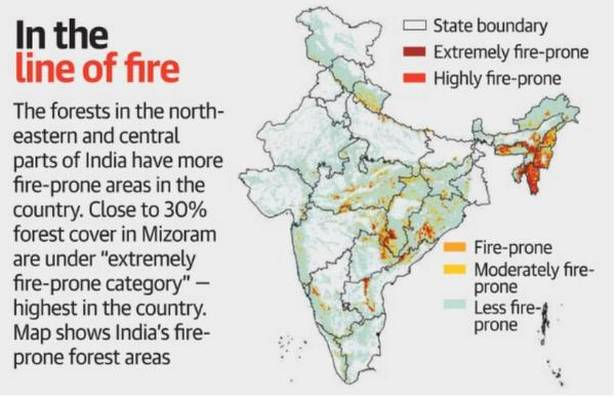One-fifth of the Country’s Forests Prone to Fire | 01 Jan 2020
Why in News
Recently, the 2019 report by Forest Survey of India (FSI) was released. It states that about 21.40% of forest cover in India is prone to fires, with forests in the north-eastern region and central India being the most vulnerable.
- FSI carried out a study along forest fire points (FFP) identified across the country from 2004 to 2017.
- There are total 2,77,758 FFP identified during the 13 years.
- FFPs were analysed using a moderate resolution imaging spectroradiometer (MODIS) by overlaying the points coverage over the grid coverage of 5 km x 5 km.
Forest Survey of India
It is a premier national organization under the Union Ministry of Environment and Forests responsible for assessment and monitoring of the forest resources of the country regularly.
Key Points
- Extremely fire-prone areas account for 3.89% of total forest cover, very highly fire-prone areas account for 6.01% and highly fire-prone areas for 11.50%. Together, the three categories come to 21.40 % of forest cover.
- From November 2018 to June 2019, there were total 29,547 alerts based on MODIS. Mizoram recorded the highest number of fire alerts (2,795).
- The north-eastern region accounted for about one-third of alerts in the country.
- The Central Indian States also recorded a high number of forest fire alerts.
- Alerts: Madhya Pradesh > Maharashtra > Odisha > Chhattisgarh
- The overall green cover has increased in the country but the forest cover in the north-east, particularly in Mizoram, Arunachal Pradesh and Nagaland, has decreased.
- The uncontrolled forest fires can lead to significant loss of forest cover. Climate change influences the frequency and intensity of forest fires and results in forests becoming increasingly inflammable.
- Reasons for Forest Fires
- Thunderstorms are the most likely natural cause for forest fires.
- In central India, the reasons are mainly manmade, particularly in cases where people visit forests and leave burning bidis, cigarette stubs or other inflammable materials.
- A major reason for forest fires in the north-east is slash-and-burn cultivation, commonly called jhoom or jhum cultivation.
- The north-east has tropical evergreen forests which are not likely to catch fire easily on their own like the dry deciduous forests of central India.

